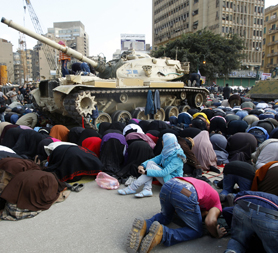Egypt: How Mubarak evaded resignation
As protesters mass in Cairo again, Channel 4 News looks into the 24 hours that saw President Mubarak face down intense pressure for his immediate resignation.

Day 17 of the Egypt protests began with the belief that President Hosni Mubarak would stand down by the end of the day. But the unyielding leader refused to relinquish power in a remarkable address which no one predicted – from the White House down to the thousands in Tahrir Square…
1200: CIA Director Leon Panetta tells U.S. Congress there was a “strong likelihood” President Mubarak would step down by the end of Thursday.
Media agencies around the world react to the Panetta statement and prepare for the official announcement.
1500: Secretary General of the ruling NDP party, Dr Hossam Badrawi, exclusively tells Channel 4 News International Editor Lindsey Hilsum that President Mubarak will be standing down.
As protesters become aware of the news through Twitter and the Internet, the mood in Egypt changes from anger to celebration. Crowds begin to grow in Tahrir Square in hope that the announcement of Mubarak’s resignation is imminent.
1700 President Barack Obama appears euphoric in preparation for Mubarak standing down. Adapting his address after hearing the news he asserts: “We want all Egyptians to know America will continue to do every thing that we can to support an orderly and genuine transition to democracy in Egypt.”
2100: President Mubarak appears on state owned TV to announce he will stay in office until September but will hand over some of his powers to Vice President Omar Suleiman through constitutional amendments.
The watching crowds in Tahrir Square chant “Down with Mubarak” as they react with widespread anger to the statement. The key opposition figure, Mohamed ElBaradei tweets “Egypt will explode. Army must save the country now.”
Statement comes from The White House: “This is not what we expected to happen, this is not what we wanted to happen.”
A shocked President Obama declares: “The Egyptian government must put forward a credible, concrete and unequivocal path toward genuine democracy, and they have not yet seized that opportunity,”
2300: ElBaradei talks to CNN: “There is no way the Egyptian people right now are ready to accept either Mubarak or his vice-president”
0000: State owned Egyptian TV airs picture of Mubarak and Suleiman discussing the future of the Presidency. Protesters camp through the night in Tahrir Square whilst many more enter the area.
Calls continue through the night for the military to take action after Mubarak’s statement.
0700: Egyptian military says it will release an “important” statement after long discussions. Protesters continue to flock to Cairo with new targets expected to include the President’s palace in Heliopolis and the state-owned TV station.
1100: Friday prayers are met with widespread emotion. AFP reports “Demonstrators sobbed as they conducted the weekly Muslim prayers in massed ranks in Cairo’s Tahrir Square. The preacher choked up as he gave the sermon and the crowd screamed “Leave! Leave!” at each mention of the hated strongman.”
NDP Secretary General Dr Badrawi tells Lindsey Hilsum that full presidential power has been devolved to the Vice-President – “The revolution won”.
1130: According to Al Arabiya protesters take over government buildings in Suez, raising fears across the worlds markets who had expected Mubarak to step down.
1200: After Friday prayers protesters begin to move towards the new targets in Cairo. As groups grow near the presidential palace, roads leading to the building are protected by military tanks.
1230: Al Arabiya reports that President Mubarak is not in al-Oruba Palace. Protesters move from Tahrir Square towards the state-owned TV headquarters.